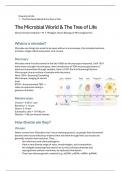Diversity of life:
1. The Microbial World & the Tree of Life
The Microbial World & The Tree of Life
(Good revision textbook = M. T. Madigan, Brock Biology of Microorganisms)
What is a microbe?
Microbes are things too small to be seen without a microscope, this includes bacteria,
archaea, single celled eukaryotes, and viruses.
Discovery:
Microbes were first discovered in the late 1800s as microscopes improved. Until 1931
there were only light microscopes, then introduction of TEM microscope (beam of
electrons transmitted through sample), then in 1937 the first Scanning Electron
Microscope (scans surface of sample with electrons).
Note: STM = Scanning Tunnelling
Microscope, imaging at atomic
level
ETEM = Environmental TEM ->
relies on specimen being in
gaseous chamber
Relative sizes:
Viruses = 0.05-0.1 µm
Bacteria = 1-10 µm
Yeast = 3-10 µm
Eukaryotic cells = 10-100 µm
Mycelia = 100 µm-several metres
How diverse are they?
Viruses:
Name comes from ‘filterable virus’ (virus meaning poison), as people first discovered
bacteria then found infectious material that still went through filter (as viruses are
generally smaller than bacteria). They…:
- Are infectious and often pathogenic.
- Have a very diverse range of sizes, morphologies, and composition.
- Are obligate (meaning they need to to survive) cellular parasites and
reprogramme cellular machinery to replicate themselves
- They have diverse genetic material (e.g. dsDNA, ssDNA, ssRNA, dsRNA)
,Prokaryotes: Bacteria vs Archaea
Archaea were discovered later, and previously assumed to be bacteria. Both are single
celled organisms with a diverse shape and size – see differences in table below.
Comparator Bacteria Archaea
Habitats Wide range Typically ‘extreme’ conditions but not
always (e.g. salt brine, sea
hydrothermal vents), not always
Cell wall Peptidoglycan (N- Pseudopeptidoglycan/polysaccharides/
acetylmuramic acid & D- Glycoproteins/proteins
amino acids)
Membrane Lipid bilayer – fatty acids Bi/monolayer or a mix of both – phytanyl
lipids ester bonded to glycerol groups ether bonded to glycerol
Glucose Glycolysis & Kreb’s cycle Neither yet found
oxidation widely found
Photosynthesis Many types found, e.g. No oxygenic photosynthesis yet found
cyanobacteria
Reproduction Binary fission, some Binary fission, no sporulation found
sporulation
Chromosome Single circular Single circular chromosome,
chromosome, no introns sometimes with introns
found
Flagella Hollow & made by adding Made by adding subunits to the base
subunits from a central
pore to the tip
tRNA Thymine No thymine
tmRNA Not found Present
RNA Simple – made of 4 Complex – over 8 polypeptides, may
polymerase polypeptides have multiple RNA polymerases
Pathogenicity Many pathogens described None found
Early Bacterial Classification:
- They were originally categorised by their shape (e.g. by Haeckel) in Monera
(prokaryotes) – this was not very useful as it did not necessarily reflect phylogeny
- As the skill of culturing was developed this allowed people to look at their
morphology and development -> the introduction of standardised agar plates
was essential for this
- Staining also became essential, for example Gram’s stain which differentiates
between Gram positive and negative bacteria.
, è Gram positive bacteria have a single cell membrane with a thick
peptidoglycan & teichoic acid layer, whilst Gram negative bacteria have a 2
membrane cell wall with a thin layer of peptidoglycan.
Eukaryotic microorganisms:
Archaeplastida = plants, red & green algae
Rhizaria = mostly heterotrophic unicellular organisms
Chromoalveolata = stramenopiles, unicellular flagellates & diatoms, alveolate,
widespread group predators & parasites
Excavata = mostly heterotrophs, including pathogens, some are anaerobic
Amaebozoa = many amoeba, e.g. slime molds
Opisthokonta = fungi, animalia
Fungi: Micro & macro-organisms
They are eukaryotic, typically have haploid nuclei, they reproduce mainly by spores
(both sexually & asexually), they have rigid cell walls made of chitin, they have a mostly
filamentous growth form, and are heterotrophic,
What is the impact of
microbes?
Global Biomass: Bacteria make up the
second largest taxa by biomass behind
plants, fungi make up the third, archaea
the 4th, and protists the 5th.
Interactions: Microbes in the soil interacting with plant roots makes up the rhizosphere,
which is important to the N-cycle.
Microbiome on people also important for gut, skin health
etc.
Evolution: Includes symbiosis and disease. E.g. aphids
have a symbiotic relationship with bacteria for mutual
nutrition. Disease also leads to mass-die offs which can lead to evolutionary
bottlenecks, as well as impacts on conservation
Human society: Impact our health – need a healthy gut microbiome, but also can be
pathogenic & cause mortality. Important to food (fermentation, makes foods go off) and
agriculture (N-cycle, legumes, microbiomes on livestock as well as disease), and
industry – used to make antibiotics, enzymes, and some chemicals, also harmful to
some processes.
, How are they classified?
Prokaryotes & Life on Earth
Earth is about 4.5 billion years old, with the first life
around 4 billion years ago. Photosynthesis started
occurring from 3.2 billion years ago, increasing O2
conc. In the atmosphere. Most of the planet’s history is microbial (large & multicellular
only far more recent).
Fossil Evidence of early bacterial life:
Stromalites found in carbonate sediments. These are made up of cyanobacteria, and
are around 3.5 billion years old (at oldest), and become abundant in rocks 2.8-3 billion
years old, showing quick spread. If life were to be found on another planet it would most
likely be microbial, and, like earth, have a proportionally similar time span before larger
organisms arise.
Classification of life over
time:
Initially described on what
could be seen, protists were
only added later after their
discovery. Phylogeny later
realised and began to use this
instead.
Pre-molecular biology timeline:
1: Linnaeus introduced binomial naming system, and began cataloguing species
2: Haeckel categorised species based on morphological complexities. Had some idea
of descent.
3: Chatton first realised eukaryotic and prokaryotic cell types by having/absence of
nucleus
4: Copeland founded 4 kingdoms based on cellular properties
5: Whittaker used 5 kingdoms based on cellular and nutritional characteristics.




